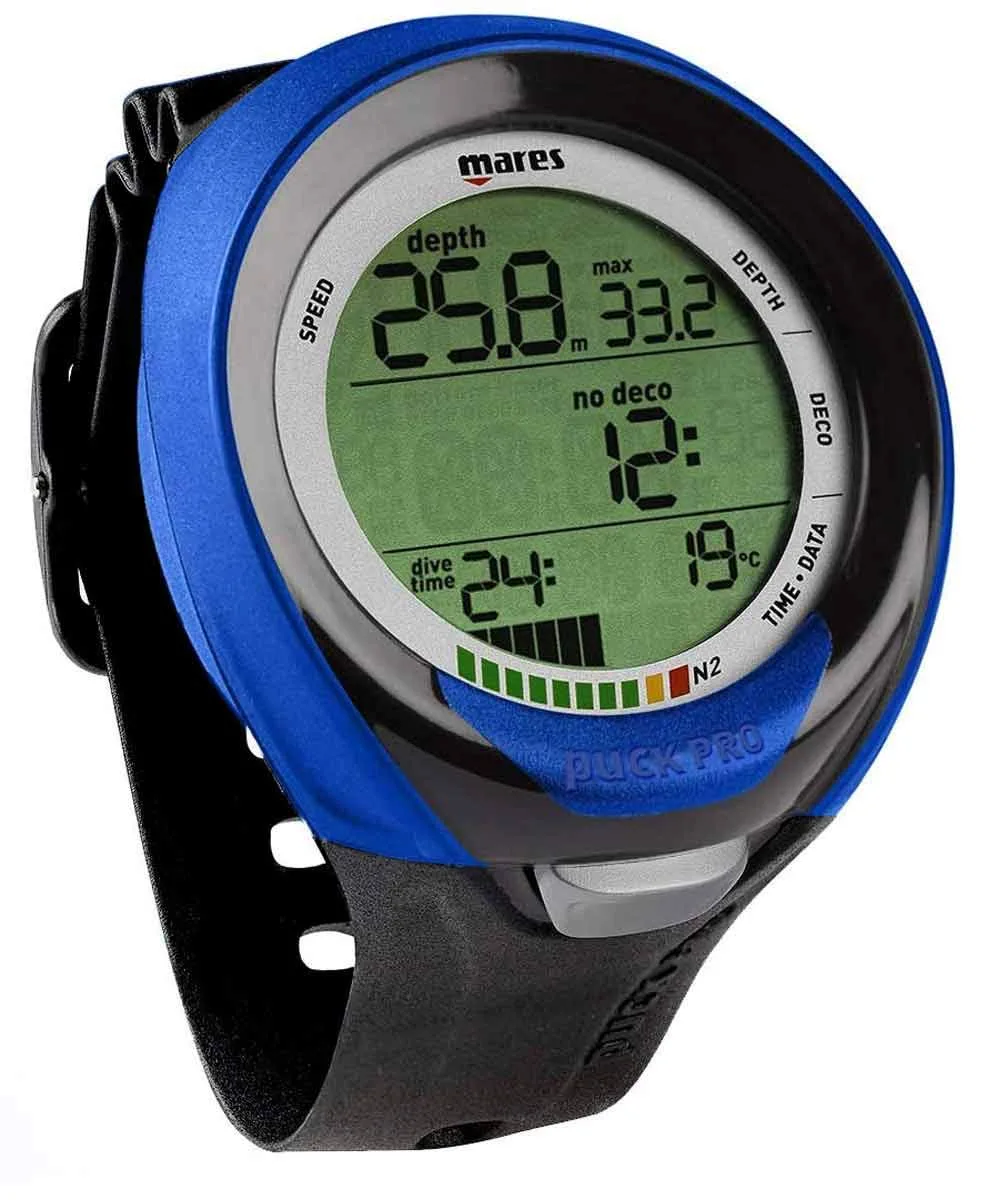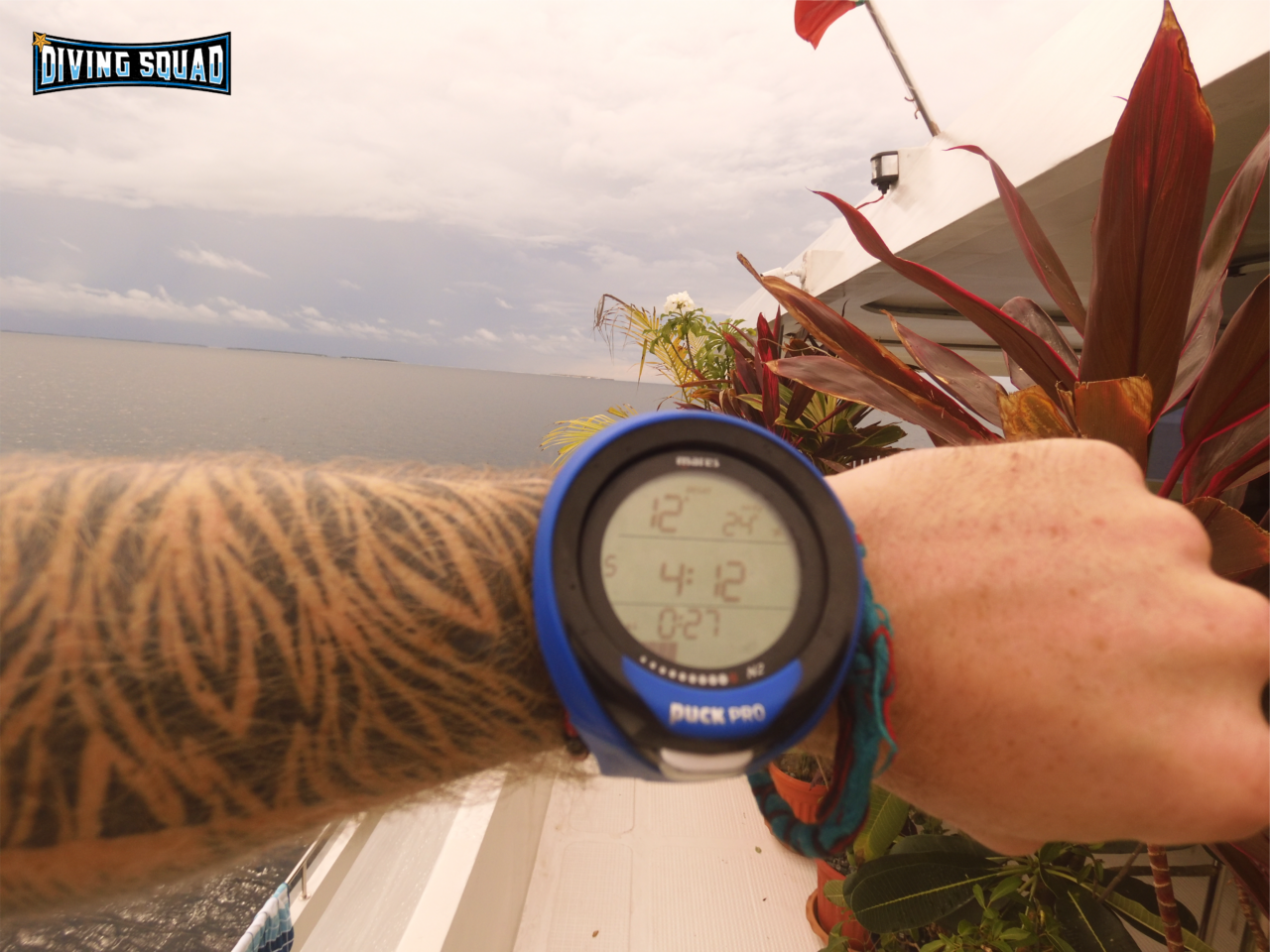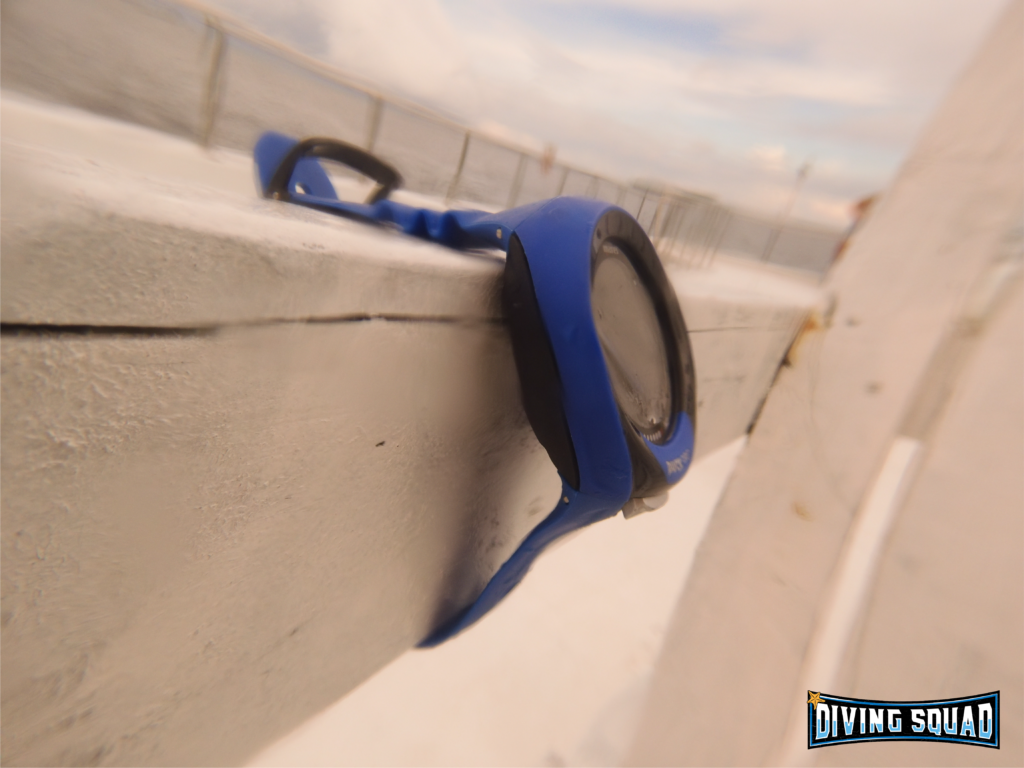
One of the cheapest dive computers of 2024, the Mares Puck Pro is also one of the largest and easiest to use; thanks to it’s massive screen, limited features and simple, one-button user interface.
It’s a durable and reliable bit of kit – it even has a couple of calibrations that other, similarly priced dive-computers lack – such as a freshwater feature and mixed gas mode for tech divers.
On top of that, it also has a massive battery life of 400 hours and to make things even easier, the lithium battery is user-replaceable which saves time and postage money!
The Puck Pro was created by Mares: an Italian based, leading manufacturer of diving equipment who’ve been around since 1949 and are renowned for creating high quality yet affordable dive gear.
Admittedly, there’s a few areas this dive computer could be improved; for example it’s dive log is tiny at just 36 hours long.
Furthermore, it lacks some features seen in more expensive dive computers like air integration or a compass. Also, like most cheap dive computers it’s too bulky to use as a wristwatch.
In this review, we’ll breakdown the Mares Puck Pro’s features; we’ll highlight it’s pros and expose the cons and also compare it to similar dive computers. Let’s dive in!
PROS:
- Affordable
- Long battery life
- Large screen = easy to read
- Easy to use
- Freshwater and Mixed Gas settings
CONS:
- Short log book (only 36 hours)
- No compass, air integration, tec or free dive mode
- Too big to use as everyday watch
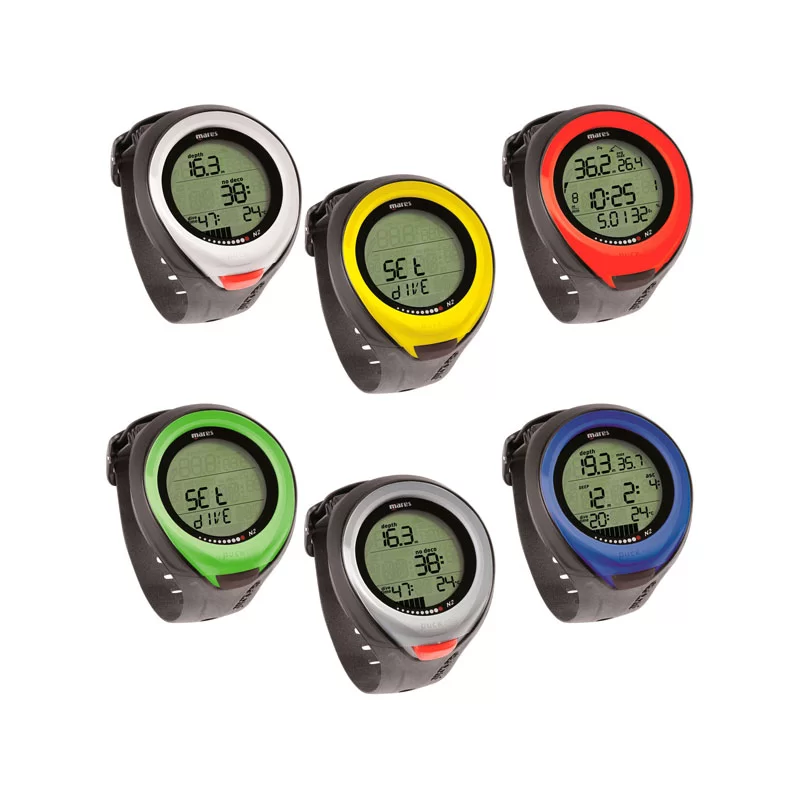
Features:
- Depth rating: 492 feet / 150 meters
- Dimensions: Diameter: 2.33 inches – Thickness: 1 inch.
- Weight: 113 grams.
Freshwater and mixed gas settings.
Data can be displayed in imperial or metric.
FEATURES:
1) Large Display with Backlight:
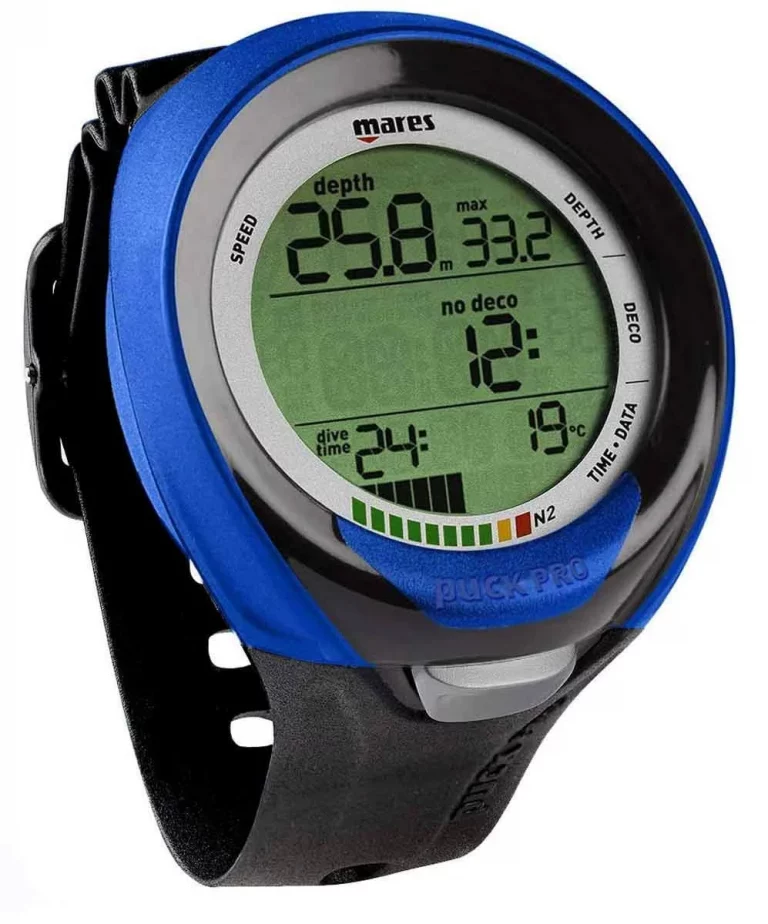
Sitting behind a tempered mineral glass face, the Mares Puck Pro’s dot-matrix LCD display is conveniently divided into three sections with depth and ascent speed on top, no-deco limits in the middle and dive time, nitrogen-loading and temperature at the bottom.
There’s a decent strength backlight to allow easy reading in low light (e.g. at night). Its activated by pressing the button and will then stay on for 1 – 10 seconds depending on which settings you’ve configured.
The LCD display is roughly 1.8 inches across, making it larger than that of most dive computers. In fact, the Mares Puck Pro is one big-ass dive computer all round, with it’s polymer bezel measuring 2.3 inches across!
Whilst this makes it robust and durable; it does mean it’s too large to wear as an everyday wrist watch.
However, having such a big screen can be advantageous as it makes the Puck Pro incredibly easy to read data off of – something that’ll be especially useful for beginner or short-sighted divers!
There’s only on dive computer with a display bigger than the Mares Puck Pro – and that’s the Cressi Leonardo.
2) Simple User-Interface:
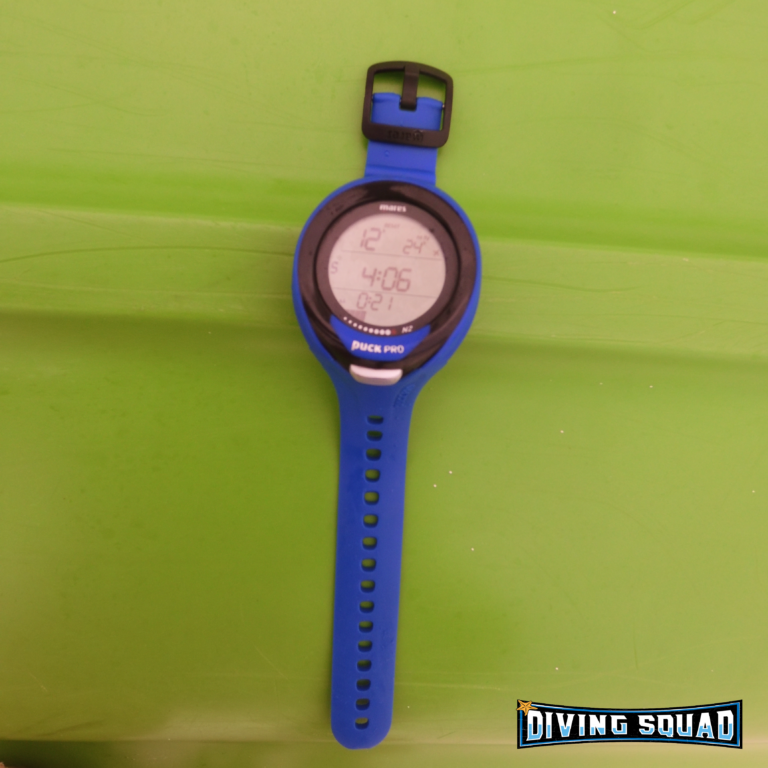
Most dive computers are operated by 2 – 5 buttons, but the Mares Puck Pro is one of the few models (the other being the Cressi Leonardo) to feature a single button user-interface.
Pressing the Puck Pro’s singular button toggles through settings and menus – whilst holding it selects. The advantage of just one button is that it makes navigating settings much simpler.
The downside is that it’s also a little slower to operate and if you accidentally go past the feature you wanted to selected you have to toggle through all the options again.
However, because the Mares Puck Pro is a fairly simple dive computer without loads of unnecessary features, there’s actually not too much to scroll through in the first place!
Generally speaking, reviewers really appreciate the single-button user-interface of the Mares Puck Pro because they find it makes it incredibly straightforward and intuitive to navigate settings.
Also, the button is large and fluid, which makes it very easy to operate even if you’re wearing thick dive gloves.
3) Modes: Air, Nitrox and Bottom-timer + Freshwater & Mixed Gas Settings
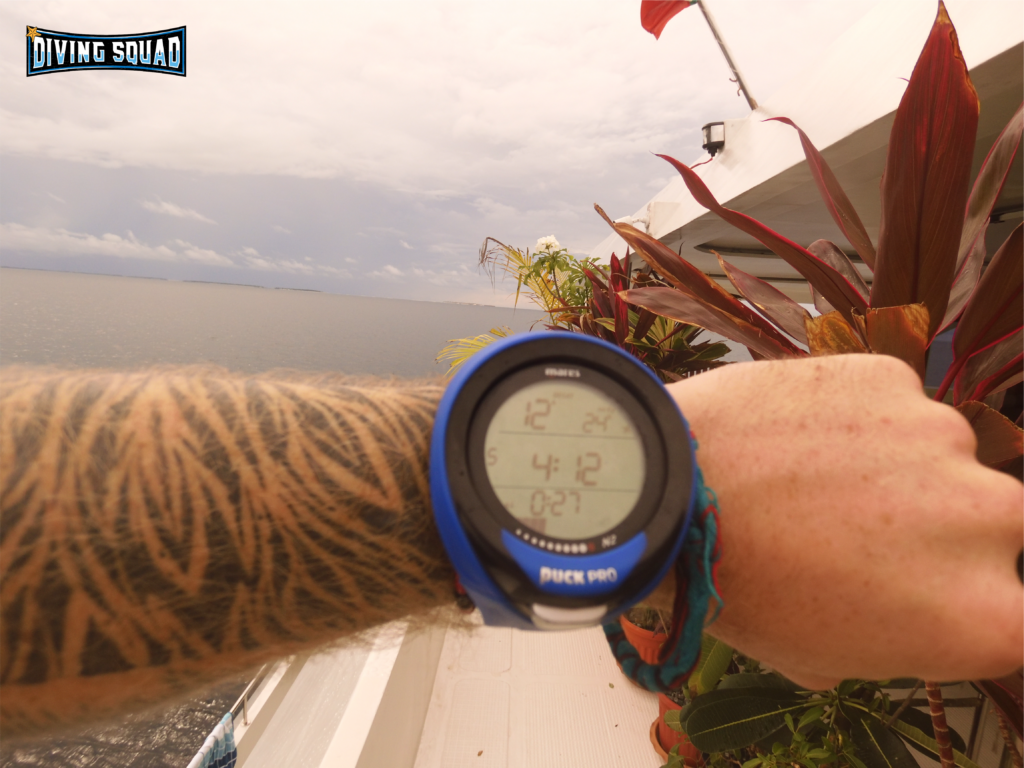
When it comes to calculating no-deco limits (the number one function of any dive computer!), there are several modes within which it can operate. In the case of the Mares Puck Pro these are:
- Air Mode: The standard mode for when scuba diving with a normal tank of air. It’s automatically activated once you descend below 4ft / 1.2 meters.
- Nitrox Mode: For when you’re diving with a nitrox mix. Within settings, you can set the ppO2 (partial pressure of oxygen) to between 1.4 and 1.6. If nitrox diving and ppO2 are something you’ve never heard of – don’t worry! Nitrox diving requires a day of special training and all these things will be explained within it.
- Bottom-Timer Mode: Usually referred to as Gauge mode, with the Mares Puck Pro its call the bottom-timer mode. It means the dive computer has stopped tracking the theoretical nitrogen mode and instead simply displays dive time in minutes and seconds. Most recreational divers will not use it.
It’s worth mentioning that all dive computers have the three modes mentioned above and more advanced ones actually have additional modes such as free dive and tec – but beginner scuba divers will not need these!
However, the Mares Puck Pro does have a few extra settings that most other similarly priced dive computers lack:
- Freshwater Setting: Handy if you’re diving in a lake. That said don’t expect to use it much – the vast majority of recreational diving occurs in saltwater. You can also adjust the altitude up to 12,100 ft in case you’re diving a mountain lake. Fancy!
- Mixed Gas Setting: For diving with two air cylinders containing different gas mixes and switching between them during the dive. To tell the truth, this sorta thing is some next-level diving that’s only undertaken by tec divers. And if you are a tec diver you’ll definitely want a dive computer more sophisticated than the Mares Puck Pro which is too conservative for tec diving. So this is a slightly pointless feature, in my opinion. I guess it’s still better to have it than not.
4) Mares-Wienke RGBM Algorithm:
RGBM stands for reduced gradient bubble model. It’s an algorithm that works alongside a dive computers depth sensor and timer to calculate how much nitrogen gas is theoretically being absorbed and released by the tissues in your body throughout a dive.
This information is used to work out your no-deco limit (basically how long you can stay at a given depth) which is essential for avoiding decompression sickness – aka the dreaded bends! No other function of a dive computer is as important as this.
Now there’s actually a handful of different decompression algorithms out there and whilst they all have the same end goal in sight, they do vary slightly, for example in terms of how conservative they are.
In the case of the Mares Puck Pro it utilises the Mares-Wienke RGBM. Wienke refers to the legendary bubble-specialist Dr. Bruce Wienke – the chap who developed the algorithm in the first place. This algorithm is so popular that it’s actually utilised by several different different dive computer manufacturers including Mares, Suunto and Cressi.
In the case of the Mares-Wienke RGBM it’s been slightly “modified” to better suit the computational limitations of Mares dive computers. The Mares RGBM calculates the theoretical uptake of gas in ten hypothetical tissue compartments and also attempts to account for free phase bubbles that may be present in the blood.
Enough science damnit! What does this mean for me, the diver?
The Mares-Wienke RGBM is an extra conservative algorithm compared to tec diving friendly algorithms – this means you may hit your no-deco limits sooner than some of your friends using other dive computers.
However, having a conservative dive computer is not at all a bad thing, especially if you’ve not been scuba diving for very long. All it means is that it’ll err on the side of caution that little bit more.
It requires safety stops, restricts deeper dives with short surface intervals and even penalises NDLs on reverse dive profiles.
So if you skip your safety stop or run a bad profile (like saw-tooth diving or pushing NDL limits) you’ll get significant penalties in the forms of limitations on repetitive dives. And if your Puck Pro thinks you’ve really misbehaved it’ll lock you out of using it for 24 hours! This is a handy feature for beginner divers as it encourages diving in a safe and responsible way – however it could seriously annoy advanced divers – but that’s not the target audience of this dive computer.
It’s also worth mention that you can also adjust the conservatism level of the Mares-Wienke RGBM on the Puck Pro to make it even more conservative. By adjusting it from the standard P0 setting to P1 and P2 which are increasingly conservative.
As we’ve just covered, what with the Puck Pro standard RGBM setting already be pretty damn conservative already, this is only necessary if you have any pre-existing medical conditions that put you more at risk.
5) Logbook:
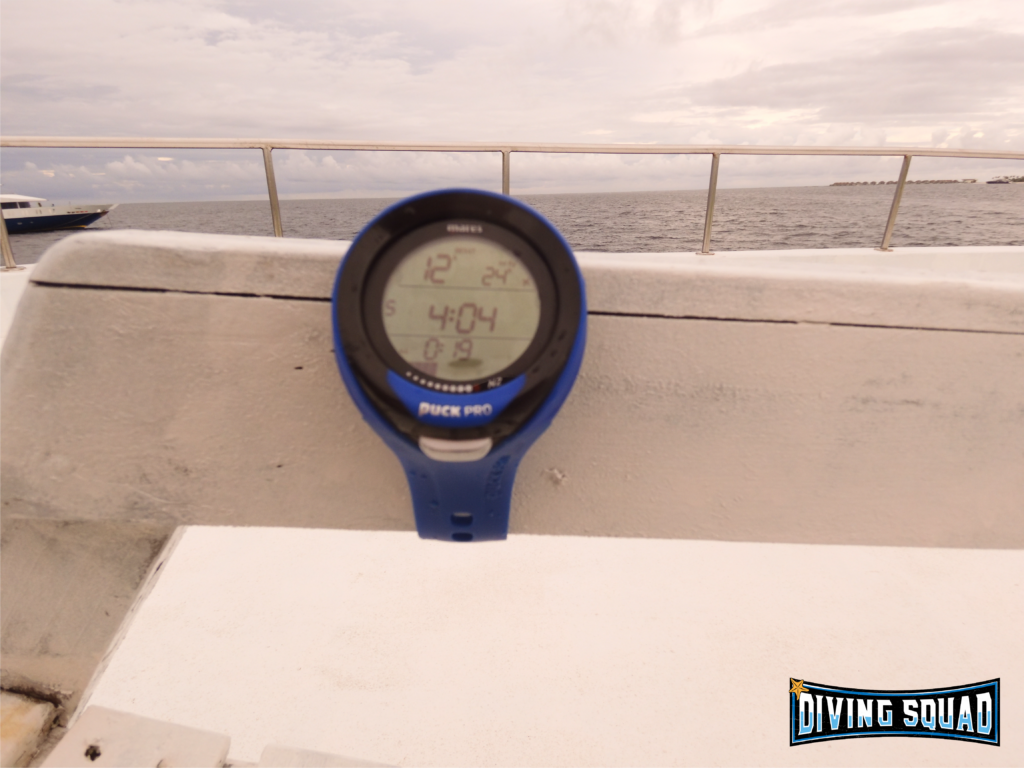
For each dive that you make, the logbook records your dive profile data including time at each depth, mode, dive entry and exit times and temperature.
This is stored on the log book which can easily be viewed on the Puck Pro itself or uploaded to a computer using the included USB stick.
At just 36 hours, the Mares Puck Pro actually has the shortest dive log of any dive computer which is a little bit of a pain in the ass cos once it’s full, older dives will be overwritten.
Still, at least the logbook is noted among users as being easier to skip through and view dive data on compared to that of other cheap dive computers!
6) Alarms & Warnings:
The Mares Puck Pro features several loud audible alarms if you exceed its recommended ascent rate (36 feet per minute), exceed the ppO2, hit the 100% central nervous system oxygen exposure limit…or if you make a decompression stop violation. Also if its battery is low! When the audible alarms are activated the backlight comes on and a warning text may flash up on the screen.
However, what the Mares Puck Pro does lack is a depth alarm. With other cheap dive computer you can programme an alarm to signal if you exceed a depth. Not so with the Puck Pro which is a bit of a shame but not essential.
The Puck Pro will also warn you about any required stops. There’s an optional deep stop function which will appear on the screen as you’re approaching your no decompression limit (NDL) or no stop time. When this appears you have the option to stop for two minutes once or stop for one minute twice.
And of course theres also the safety stop which will appear along with 3 minute countdown once you ascend to 20 feet from surface.
7) User-Replaceable Battery:
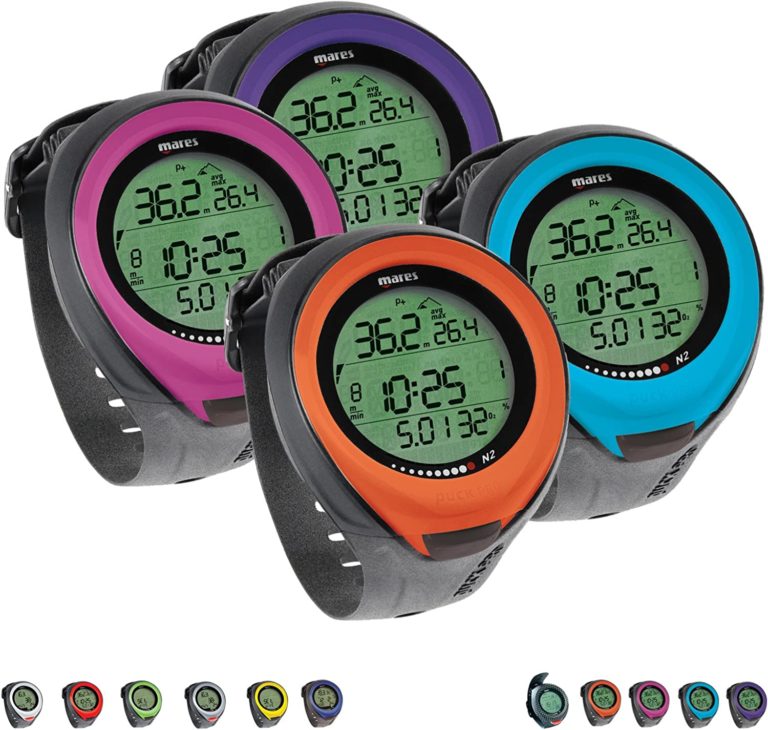
Although a lot of low-budget and even mid-priced dive computers have to be sent off to the closest service centre of their manufacturer in order to have their battery replaced, the Mares Puck Pro is pretty neat in that it’s 3V lithium battery can easily be replaced by you. All you need is the right-sized screwdriver and a new O-ring ready to go (you should change the O-ring every time you change the battery).
Do note however that any improper use leading to water damage including a dirty seal and the battery compartment closed incorrectly may lead to the warranty being voided. So if you are going to change the battery yourself…do it right!
To learn how to change the battery: check out the user-manual here.
Other Bits and Bobs
After sales and servicing support:
A highly esteemed brand, Mares are generally pretty on the ball when it comes to responding to any problems customers have with their products.
They offer a 2 year warranty for the Mares Puck Pro – if there are any defects with it due to manufacturer error they will fix or replace it, provided it fits with their guidelines. You can check out the Mares warranty guidelines here:
Mares Puck Pro VS Cressi Leonardo:
It may seem a little random comparing two specific makes of dive computer created by different manufacturers when there are so very many different models of dive computer out there.
However the question “which is better – the Mares Puck Pro or Cressi Leonardo“? actually gets tossed about more than you might expect.
Why? Well it’s because these two dive computers have quite a lot in common: they’re both cheap dive computers that are designed for beginners and they both have large screens, single-button user interfaces and user-replaceable batteries.
So which IS the best? Let’s take a look:
Ways in which the Mares Puck Pro is better than the Cressi Leonardo:
- It includes a USB cable with which to transfer data from the logbook to a PC or Mac easily. The Cressi Leonardo on the other hand requires that you purchase a separate device to do this and it costs almost one hundred bucks. Boo!
- The Mares Puck Pro has a much longer battery life – 400 hours vs the Cressi Leonardos 150 hours. Yay!
- The Puck Pro allows you to dive with it in freshwater and for gas-mixing calibrations. In honesty though, both these situations are pretty unlikely to occur for a beginner diver. Still useful to have though!
Ways in which the Cressi Leonardo is better than the Mares Puck Pro:
- The Cressi Leonardo is over one hundred bucks cheaper. That’s pretty damn significant when you consider that one of the main selling points for these dive computers is their affordability.
- The Cressi Leonardo has a longer log book at 70 hours long vs the Mares Puck Pros somewhat feeble 36 hour log book.
- The screen of the Leonardo is ever so slightly larger.
Ultimately there’s no clear-cut winner between these dive computers. It really depends on what you’re looking for.
If affordability or a bigger log book are your top priorities then go for the Cressi Leonardo; also if you’d like a bigger dive log. But do remember that without if you plan to upload your log book data to a PC or Mac, buying the special device required to do so for the Cressi Leonardo will even out the price between the two.
However, if you want a dive computer with a longer battery life, the ability to dive in freshwater or with gas mixing and that’s easy to transfer data from the log book to a PC or MAC – choose the Mares Puck Pro all the way!
Ongoing Maintenance:
With it’s sturdy and robust polymer casing and tempered (shatter-proof) glass covering the display, the Mares Puck Pro is an exceptionally durable dive computer – more so even than many of the more expensive models of dive computer out there.
It’s pretty hard to break – that said there is one thing you’ll absolutely want to make sure you do with it after every dive and that’s rinse it in freshwater.
Luckily all dive centres and liveaboards have basins filled with freshwater for just such an occasion. Make sure you place your Mares Puck Pro in the basin for delicate equipment i.e. dive computers and cameras and not the one for bcds and fins etc!
Place your dive computer in the correct basin of freshwater and repeatedly press its button – ten to twenty times should suffice or until no more tiny bubbles escape from around the sides of the button as you press it. Feel free to even leave your dive computer in the basin for several minutes as you rinse down the rest of your kit.
As with all scuba diving gear, it’s really important that you rinse your Mares Puck Pro dive computer in freshwater after every use because saltwater corrodes and over time can lead to defects in equipment or at the very least a button that does not press down so easily.
Besides that you should be good. Just don’t expose it to any extreme temperatures or severe knocks against hard surfaces. And do remember that if you’re going to change the battery yourself – do it properly! Refer to the user-manual.
Alternatively, feel free to send it off to your nearest Mares service centre. And if a more serious fault develops – don’t try to fix it yourself. Who you gonna call? That’s right. Mares. Send it to them. They’ll sort it. Here’s their contact page.
FINAL VERDICT:
For such an affordable dive computer, the Mares Puck Pro packs a sizeable punch!
It performs all of the essential functions required of a dive computer; whilst being reliable, durable and easy to use.
This is a no frills bit of kit and it’s target audience: beginner divers are sure to appreciate it’s simplicity both in terms of it’s intuitive user-interface, huge screen and not being burdened with unnecessary extra features.
More advanced divers however, may find themselves longing for those extra features that the Puck Pro lacks such as a compass, air integration or tec mode.
However – the Mares Puck Pro wasn’t designed for advanced divers. It was designed for newbie scuba divers on a budget and among those of its reviewers it frequently gets cited as an all time favourite!
